Bibliometric Review of Magnetorheological Materials
Abstract
:1. Introduction
2. Materials and Methods
2.1. Related Studies
2.2. Data Preparation
2.3. Author Domination
2.4. The Use of Keywords
2.5. Authors Impact and Collaboration
3. Results and Discussion
4. Conclusions
Author Contributions
Funding
Institutional Review Board Statement
Informed Consent Statement
Data Availability Statement
Acknowledgments
Conflicts of Interest
References
- Yang, G.; Spencer, B.F., Jr.; Carlson, J.D.; Sain, M.K. Large-scale MR fluid dampers: Modeling and dynamic performance considerations. Eng. Struct. 2002, 24, 309–323. [Google Scholar] [CrossRef]
- Carlson, J.D.; Jolly, M.R. MR fluid, foam and elastomer devices. Mechatronics 2000, 10, 555–569. [Google Scholar] [CrossRef]
- Scherer, C.; Figueiredo Neto, A.M. Ferrofluids: Properties and applications. Braz. J. Phys. 2005, 35, 718–727. [Google Scholar] [CrossRef]
- Vatandoost, H.; Hemmatian, M.; Sedaghati, R.; Rakheja, S. Dynamic Characterization of Isotropic and Anisotropic Magnetorheological Elastomers in the Oscillatory Squeeze Mode Superimposed on Large Static Pre-Strain. Compos. Part B Eng. 2020, 182, 107648. [Google Scholar] [CrossRef]
- Lerner, A.A.; Cunefare, K.A. Performance of MRE-Based Vibration Absorbers. J. Intell. Mater. Syst. Struct. 2008, 19, 551–563. [Google Scholar] [CrossRef]
- Park, B.J.; Fang, F.F.; Choi, H.J. Magnetorheology: Materials and application. Soft Matter 2010, 6, 5246–5253. [Google Scholar] [CrossRef]
- Lokander, M.; Stenberg, B. Performance of isotropic magnetorheological rubber materials. Polym. Test. 2003, 22, 245–251. [Google Scholar] [CrossRef] [Green Version]
- Kubík, M.; Válek, J.; Žáček, J.; Jeniš, F.; Borin, D.; Strecker, Z.; Mazůrek, I. Transient response of magnetorheological fluid on rapid change of magnetic field in shear mode. Sci. Rep. 2022, 12, 10612. [Google Scholar] [CrossRef] [PubMed]
- Ginder, J.M.; Nichols, M.E.; Elie, L.D.; Clark, S.M. Controllable-Stiffness Components Based on Magnetorheological Elastomers. In Proceedings of the SPIE’s 7th Annual International Symposium on Smart Structures and Materials, Newport Beach, CA, USA, 6–9 March 2000. [Google Scholar] [CrossRef]
- Kikuchi, T.; Noma, J.; Akaiwa, S.; Ueshima, Y. Response time of magnetorheological fluid–based haptic device. J. Intell. Mater. Syst. Struct. 2016, 27, 859–865. [Google Scholar] [CrossRef]
- Stepanov, G.V.; Abramchuk, S.S.; Grishin, D.A.; Nikitin, L.V.; Kramarenko, E.Y.; Khokhlov, A.R. Effect of a homogeneous magnetic field on the viscoelastic behavior of magnetic elastomers. Polymer 2007, 48, 488–495. [Google Scholar] [CrossRef]
- Kankanala, S.V.; Triantafyllidis, N. On finitely strained magnetorheological elastomers. J. Mech. Phys. Solids 2004, 52, 2869–2908. [Google Scholar] [CrossRef]
- Wei, Y.; Lv, J.; Tang, Z.; Yang, L.; Wu, M.; Zhao, T.; Yin, H. A universal rheological constitutive equation of magnetorheological fluids with a wide shear rate range. J. Magn. Magn. Mater. 2022, 563, 169811. [Google Scholar] [CrossRef]
- Zhang, H.; Hu, Z.; Lei, Y.; Wang, D.; Zhao, H.; Jiang, H. Enhanced performances of magnetorheological fluids based on weakly magnetic organogel. J. Magn. Magn. Mater. 2022, 560, 169572. [Google Scholar] [CrossRef]
- Odenbach, S. Microstructure and rheology of magnetic hybrid materials. Arch. Appl. Mech. 2016, 86, 269–279. [Google Scholar] [CrossRef]
- Yu, M.; Ju, B. Dynamic mechanical properties testing for shear mode of magnetorheological elastomer. Gongneng Cailiao/J. Funct. Mater. 2011, 42, 1939–1942+1946. Available online: www.scopus.com (accessed on 14 November 2022).
- Odenbach, S. Recent progress in magnetic fluid research. J. Phys. Condens. Matter 2004, 16, R1135–R1150. [Google Scholar] [CrossRef]
- Polunin, V.M.; Ryapolov, P.A.; Platonov, V.B.; Sheldeshova, E.V.; Karpova, G.V.; Aref’ev, I.M. Elasticity of a magnetic fluid in a strong magnetic field. Acoust. Phys. 2017, 63, 416–423. [Google Scholar] [CrossRef]
- Zahn, M. Magnetic fluid and nanoparticle applications to nanotechnology. J. Nanoparticle Res. 2001, 3, 73–78. [Google Scholar] [CrossRef]
- Zhang, Y.; Wang, Y.; Wang, Y.; He, J.; Ji, F.; Huang, W. Dwell time algorithm based on the optimization theory for magnetorheological finishing. In Proceedings of the 5th International Symposium on Advanced Optical Manufacturing and Testing Technologies, Dalian, China, 26–29 April 2010; Volume 7655. [Google Scholar] [CrossRef]
- Rabinow, J. Magnetic-Fluid Control Devices; SAE Technical Papers: Warrendale, PA, USA, 1949. [Google Scholar] [CrossRef]
- Rabinow, J. The Magnetic Fluid Clutch. Trans. Am. Inst. Electr. Eng. 1948, 67, 1308–1315. [Google Scholar] [CrossRef]
- Jolly, M.R.; Carlson, J.D.; Muñoz, B.C. A Model of the Behaviour of Magnetorheological Materials. Smart Mater. Struct. 1996, 5, 607–614. [Google Scholar] [CrossRef]
- Rankin, P.J.; Horvath, A.T.; Klingenberg, D.J. Magnetorheology in Viscoplastic Media. Rheol. Acta 1999, 38, 471–477. [Google Scholar] [CrossRef]
- Xu, Y.; Gong, X.; Xuan, S.; Zhang, W.; Fan, Y. A High-Performance Magnetorheological Material: Preparation, Characterization and Magnetic-Mechanic Coupling Properties. Soft Matter 2011, 7, 5246–5254. [Google Scholar] [CrossRef]
- Shiga, T.; Okada, A.; Kurauchi, T. Magnetroviscoelastic Behavior of Composite Gels. J. Appl. Polym. Sci. 1995, 58, 787–792. [Google Scholar] [CrossRef]
- Mao, R.; Wang, X.; Cai, S.; Zhang, G.; Wang, J. Strain dependent magneto-mechanical property of magnetorheological gel composite: Rheological measurement and model establishment. Compos. Sci. Technol. 2022, 227, 109612. [Google Scholar] [CrossRef]
- Spencer, B.F., Jr.; Dyke, S.J.; Sain, M.K.; Carlson, J.D. Phenomenological model for magnetorheological dampers. J. Eng. Mech. 1997, 123, 230–238. [Google Scholar] [CrossRef]
- Pérez-Acebo, H.; Linares-Unamunzaga, A.; Abejón, R.; Rojí, E. Research trends in pavement management during the first years of the 21st century: A bibliometric analysis during the 2000–2013 period. Appl. Sci. 2018, 8, 1041. [Google Scholar] [CrossRef] [Green Version]
- He, H.; Dyck, M.; Lv, J. The heat pulse method for soil physical measurements: A bibliometric analysis. Appl. Sci. 2020, 10, 6171. [Google Scholar] [CrossRef]
- Sebastiá-Frasquet, M.; Aguilar-Maldonado, J.; Herrero-Durá, I.; Santamaría-Del-ángel, E.; Morell-Monzó, S.; Estornell, J. Advances in the monitoring of algal blooms by remote sensing: A bibliometric analysis. Appl. Sci. 2020, 10, 7877. [Google Scholar] [CrossRef]
- Liu, H.; Luo, Y.; Geng, J.; Yao, P. Research hotspots and frontiers of product R&D management under the background of the digital intelligence era-bibliometrics based on citespace and histcite. Appl. Sci. 2021, 11, 6759. [Google Scholar] [CrossRef]
- Junquera, B.; Mitre, M. Value of bibliometric analysis for research policy: A case study of spanish research into innovation and technology management. Scientometrics 2007, 71, 443–454. [Google Scholar] [CrossRef]
- Casadesus-Masanell, R.; Ricart, J.E. How to design a winning business model. Harv. Bus. Rev. 2011, 89, 100–107. [Google Scholar]
- Aria, M.; Cuccurullo, C. Bibliometrix: An R-tool for comprehensive science mapping analysis. J. Informetr. 2017, 11, 959–975. [Google Scholar] [CrossRef]
- Van Eck, N.J.; Waltman, L. Software survey: VOSviewer, a computer program for bibliometric mapping. Scientometrics 2010, 84, 523–538. [Google Scholar] [CrossRef] [PubMed] [Green Version]
- Van Eck, N.J.; Waltman, L. Citation-based clustering of publications using CitNetExplorer and VOSviewer. Scientometrics 2017, 111, 1053–1070. [Google Scholar] [CrossRef] [Green Version]
- Moral-Muñoz, J.A.; Herrera-Viedma, E.; Santisteban-Espejo, A.; Cobo, M.J. Software tools for conducting bibliometric analysis in science: An up-to-date review. Prof. De La Inf. 2020, 29, 1–20. [Google Scholar] [CrossRef] [Green Version]
- Zhu, S.; Li, L.; Gu, Z.; Chen, C.; Zhao, Y. 15 years of small: Research trends in nanosafety. Small 2020, 16, 2000980. [Google Scholar] [CrossRef] [PubMed]
- Merigó, J.M.; Pedrycz, W.; Weber, R.; de la Sotta, C. Fifty years of information sciences: A bibliometric overview. Inf. Sci. 2018, 432, 245–268. [Google Scholar] [CrossRef]
- Chen, Y.; Cheng, Z.; Wang, C.; Chen, Y.; Li, S.; Wan, Y.; Jin, Q. A bibliometric analysis for the research on laser processing based on web of science. J. Laser Appl. 2020, 32, 022001. [Google Scholar] [CrossRef]
- Zhu, S.; Liu, Y.; Gu, Z.; Zhao, Y. A bibliometric analysis of advanced healthcare materials: Research trends of biomaterials in healthcare application. Adv. Healthc. Mater. 2021, 10, 2002222. [Google Scholar] [CrossRef] [PubMed]
- Zhang, M.; Gao, Z.; Zheng, T.; Ma, Y.; Wang, Q.; Gao, M.; Sun, X. A bibliometric analysis of biodiesel research during 1991–2015. J. Mater. Cycles Waste Manag. 2018, 20, 10–18. [Google Scholar] [CrossRef]
- Jiao, Y.; Li, D.; Wang, M.; Gong, T.; Sun, M.; Yang, T. A scientometric review of biochar preparation research from 2006 to 2019. Biochar 2021, 3, 283–298. [Google Scholar] [CrossRef]
- Davarazar, M.; Kamali, M.; Lopes, I. Engineered nanomaterials for (waste)water treatment—A scientometric assessment and sustainability aspects. NanoImpact 2021, 22, 100316. [Google Scholar] [CrossRef]
- Maier, A.; Manea, D.L. Perspective of using magnesium oxychloride cement (MOC) and wood as a composite building material: A bibliometric literature review. Materials 2022, 15, 1772. [Google Scholar] [CrossRef]
- Park, J.Y.; Nagy, Z. Comprehensive analysis of the relationship between thermal comfort and building control research—A data-driven literature review. Renew. Sustain. Energy Rev. 2018, 82, 2664–2679. [Google Scholar] [CrossRef]
- Md Khudzari, J.; Kurian, J.; Tartakovsky, B.; Raghavan GS, V. Bibliometric analysis of global research trends on microbial fuel cells using scopus database. Biochem. Eng. J. 2018, 136, 51–60. [Google Scholar] [CrossRef]
- Gutiérrez-Salcedo, M.; Martínez, M.Á.; Moral-Munoz, J.A.; Herrera-Viedma, E.; Cobo, M.J. Some bibliometric procedures for analyzing and evaluating research fields. Appl. Intell. 2018, 48, 1275–1287. [Google Scholar] [CrossRef]
- Tang, M.; Liao, H.; Wan, Z.; Herrera-Viedma, E.; Rosen, M.A. Ten years of sustainability (2009 to 2018): A bibliometric overview. Sustainability 2018, 10, 1655. [Google Scholar] [CrossRef]
- Janik, A.; Ryszko, A.; Szafraniec, M. Scientific landscape of smart and sustainable cities literature: A bibliometric analysis. Sustainability 2020, 12, 779. [Google Scholar] [CrossRef] [Green Version]
- Agbo, F.J.; Oyelere, S.S.; Suhonen, J.; Tukiainen, M. Scientific production and thematic breakthroughs in smart learning environments: A bibliometric analysis. Smart Learn. Environ. 2021, 8, 1–25. [Google Scholar] [CrossRef]
- Kumar, R.; Goel, P. Exploring the domain of interpretive structural modelling (ISM) for sustainable future panorama: A bibliometric and content analysis. Arch. Comput. Methods Eng. 2022, 29, 2781–2810. [Google Scholar] [CrossRef]
- Kumar, R.; Rani, S.; Awadh, M.A. Exploring the application sphere of the internet of things in industry 4.0: A review, bibliometric and content analysis. Sensors 2022, 22, 4276. [Google Scholar] [CrossRef] [PubMed]
- Dzogbewu, T.C.; Amoah, N.; Fianko, S.K.; Afrifa, S.; De Beer, D. Additive manufacturing towards product production: A bibliometric analysis. Manuf. Rev. 2022, 9, 1–21. [Google Scholar] [CrossRef]
- Kim, H.M.; Jeong, J.Y.; Kang, S.H.; Jin, H.-J.; Choi, H.J. Dual electrorheological and magnetorheological behaviors of poly(N-methyl aniline) coated ZnFe2O4 composite particles. Materials 2022, 15, 2677. [Google Scholar] [CrossRef] [PubMed]
- Choi, S.-B.; Lee, S.-K.; Park, Y.-P. A hysteresis model for the field-dependent damping force of a magnetorheological damper. J. Sound Vib. 2001, 245, 375–383. [Google Scholar] [CrossRef]
- Kang, B.-H.; Kim, B.-G.; Jung, D.; Choi, S.-B. A mathematical model of cavitation behaviour in a single-ended magnetorheological damper: Experimental validation. Smart Mater. Struct. 2022, 31, 035012. [Google Scholar] [CrossRef]
- Zaini, N.; Mohamad, N.; Mazlan, S.A.; Aziz, S.A.A.; Choi, S.-B.; Hapipi, N.M.; Ubaidillah, U. The effect of graphite additives on magnetization, resistivity and electrical conductivity of magnetorheological plastomer. Materials 2021, 14, 7484. [Google Scholar] [CrossRef]
- Mohd Nasir, N.A.; Nazmi, N.; Mohamad, N.; Ubaidillah, U.; Nordin, N.A.; Mazlan, S.A.; Yunus, N.A. Rheological performance of magnetorheological grease with embedded graphite additives. Materials 2021, 14, 5091. [Google Scholar] [CrossRef] [PubMed]
- Fakhree, M.A.M.; Nordin, N.A.; Nazmi, N.; Mazlan, S.A.; Aziz, S.A.A.; Ubaidillah, U.; Choi, S. Field-dependent rheological properties of magnetorheological elastomer with fountain-like particle chain alignment. Micromachines 2022, 13, 492. [Google Scholar] [CrossRef]
- Rohim, M.A.S.; Nazmi, N.; Bahiuddin, I.; Mazlan, S.A.; Norhaniza, R.; Yamamoto, S.; Abdul Aziz, S.A. Prediction for magnetostriction magnetorheological foam using machine learning method. J. Appl. Polym. Sci. 2022, 139, e52798. [Google Scholar] [CrossRef]
- Hu, G.; Wu, L.; Deng, Y.; Yu, L.; Li, G. Optimal design and performance analysis of magnetorheological damper based on multiphysics coupling model. J. Magn. Magn. Mater. 2022, 558, 169527. [Google Scholar] [CrossRef]
- Zhang, J.; Qiao, Y.; Zhang, M.; Zhai, P. Magnetorheological behavior of isotropic silicone rubber-based magnetorheological elastomers under coupled static-dynamic compressive loads. Smart Mater. Struct. 2022, 31, 095010. [Google Scholar] [CrossRef]
- Zhang, B.; Li, Q.; Cao, Y.; Qie, J.; Zou, J.; You, J.; Wang, G. The effect of graphene-coating material (G-fe) on the dynamic mechanical characteristics of magnetorheological elastomer (MRE). Appl. Phys. A Mater. Sci. Process. 2022, 128, 657. [Google Scholar] [CrossRef]
- Ubaidillah; Sutrisno, J.; Purwanto, A.; Mazlan, S.A. Recent progress on magnetorheological solids: Materials, fabrication, testing, and applications. Adv. Eng. Mater. 2015, 17, 563–597. [Google Scholar] [CrossRef]
- Widodo, P.J.; Budiana, E.P.; Ubaidillah, U.; Imaduddin, F. Magnetically-induced pressure generation in magnetorheological fluids under the influence of magnetic fields. Appl. Sci. 2021, 11, 9807. [Google Scholar] [CrossRef]
- Xie, H.; Zhang, Y.; Wu, Z.; Lv, T. A bibliometric analysis on land degradation: Current status, development, and future directions. Land 2020, 9, 28. [Google Scholar] [CrossRef] [Green Version]
- Sidhu, A.S.; Singh, S.; Kumar, R. Bibliometric analysis of entropy weights method for multi-objective optimization in machining operations. Mater. Today Proc. 2021, 50, 1248–1255. [Google Scholar] [CrossRef]
- Li, Y.; Li, J.; Li, W.; Samali, B. Development and Characterization of a Magnetorheological Elastomer Based Adaptive Seismic Isolator. Smart Mater. Struct. 2013, 22, 035005. [Google Scholar] [CrossRef]
- Zhao, R.; Kim, Y.; Chester, S.A.; Sharma, P.; Zhao, X. Mechanics of Hard-Magnetic Soft Materials. J. Mech. Phys. Solids 2019, 124, 244–263. [Google Scholar] [CrossRef]
- Yang, J.; Du, H.; Li, W.; Li, Y.; Li, J.; Sun, S.; Deng, H.X. Experimental Study and Modeling of a Novel Magnetorheological Elastomer Isolator. Smart Mater. Struct. 2013, 22, 117001. [Google Scholar] [CrossRef]
- Jung, H.S.; Kwon, S.H.; Choi, H.J.; Jung, J.H.; Kim, Y.G. Magnetic Carbonyl Iron/Natural Rubber Composite Elastomer and Its Magnetorheology. Compos. Struct. 2016, 136, 106–112. [Google Scholar] [CrossRef]
- Sorokin, V.V.; Ecker, E.; Stepanov, G.V.; Shamonin, M.; Monkman, G.J.; Kramarenko, E.Y.; Khokhlov, A.R. Experimental Study of the Magnetic Field Enhanced Payne Effect in Magnetorheological Elastomers. Soft Matter 2014, 10, 8765–8776. [Google Scholar] [CrossRef]
- Hu, T.; Xuan, S.; Ding, L.; Gong, X. Stretchable and Magneto-Sensitive Strain Sensor Based on Silver Nanowire-Polyurethane Sponge Enhanced Magnetorheological Elastomer. Mater. Des. 2018, 156, 528–537. [Google Scholar] [CrossRef]
- Javili, A.; Chatzigeorgiou, G.; Steinmann, P. Computational Homogenization in Magneto-Mechanics. Int. J. Solids Struct. 2013, 50, 4197–4216. [Google Scholar] [CrossRef]
- Yu, K.; Fang, N.X.; Huang, G.; Wang, Q. Magnetoactive Acoustic Metamaterials. Adv. Mater. 2018, 30, 1706348. [Google Scholar] [CrossRef] [PubMed]
- Yeh, J.Y. Vibration Analysis of Sandwich Rectangular Plates with Magnetorheological Elastomer Damping Treatment. Smart Mater. Struct. 2013, 22, 035010. [Google Scholar] [CrossRef]
- Jackson, J.A.; Messner, M.C.; Dudukovic, N.A.; Smith, W.L.; Bekker, L.; Moran, B.; Golobic, A.M.; Pascall, A.J.; Duoss, E.B.; Loh, K.J.; et al. Field Responsive Mechanical Metamaterials. Sci. Adv. 2018, 4, eaau6419. [Google Scholar] [CrossRef] [Green Version]
- Kramarenko, E.Y.; Chertovich, A.V.; Stepanov, G.V.; Semisalova, A.S.; Makarova, L.A.; Perov, N.S.; Khokhlov, A.R. Magnetic and Viscoelastic Response of Elastomers with Hard Magnetic Filler. Smart Mater. Struct. 2015, 24, 035002. [Google Scholar] [CrossRef]
- Sorokin, V.V.; Stepanov, G.V.; Shamonin, M.; Monkman, G.J.; Khokhlov, A.R.; Kramarenko, E.Y. Hysteresis of the Viscoelastic Properties and the Normal Force in Magnetically and Mechanically Soft Magnetoactive Elastomers: Effects of Filler Composition, Strain Amplitude and Magnetic Field. Polymer 2015, 76, 191–202. [Google Scholar] [CrossRef]
- Galipeau, E.; Ponte Castañeda, P. A Finite-Strain Constitutive Model for Magnetorheological Elastomers: Magnetic Torques and Fiber Rotations. J. Mech. Phys. Solids 2013, 61, 1065–1090. [Google Scholar] [CrossRef]
- Xu, Y.; Gong, X.; Xuan, S. Soft Magnetorheological Polymer Gels with Controllable Rheological Properties. Smart Mater. Struct. 2013, 22, 075029. [Google Scholar] [CrossRef]
- Wang, D.M.; Hou, Y.F.; Tian, Z.Z. A Novel High-Torque Magnetorheological Brake with a Water Cooling Method for Heat Dissipation. Smart Mater. Struct. 2013, 22, 025019. [Google Scholar] [CrossRef]
- Dargahi, A.; Sedaghati, R.; Rakheja, S. On the Properties of Magnetorheological Elastomers in Shear Mode: Design, Fabrication and Characterization. Compos. Part B Eng. 2019, 159, 269–283. [Google Scholar] [CrossRef]
- Cvek, M.; Mrlík, M.; Ilčíková, M.; Mosnáček, J.; Münster, L.; Pavlínek, V. Synthesis of Silicone Elastomers Containing Silyl-Based Polymer-Grafted Carbonyl Iron Particles: An Efficient Way to Improve Magnetorheological, Damping, and Sensing Performances. Macromolecules 2017, 50, 2189–2200. [Google Scholar] [CrossRef]
- Rudykh, S.; Bertoldi, K. Stability of Anisotropic Magnetorheological Elastomers in Finite Deformations: A Micromechanical Approach. J. Mech. Phys. Solids 2013, 61, 949–967. [Google Scholar] [CrossRef]
- Stoll, A.; Mayer, M.; Monkman, G.J.; Shamonin, M. Evaluation of Highly Compliant Magneto-Active Elastomers with Colossal Magnetorheological Response. J. Appl. Polym. Sci. 2014, 131, 1–7. [Google Scholar] [CrossRef]
- Biller, A.M.; Stolbov, O.V.; Raikher, Y.L. Modeling of Particle Interactions in Magnetorheological Elastomers. J. Appl. Phys. 2014, 116, 114904. [Google Scholar] [CrossRef]
- Wang, S.; Jiang, W.; Jiang, W.; Ye, F.; Mao, Y.; Xuan, S.; Gong, X. Multifunctional Polymer Composite with Excellent Shear Stiffening Performance and Magnetorheological Effect. J. Mater. Chem. C 2014, 2, 7133–7140. [Google Scholar] [CrossRef]
- Aguib, S.; Nour, A.; Zahloul, H.; Bossis, G.; Chevalier, Y.; Lançon, P. Dynamic Behavior Analysis of a Magnetorheological Elastomer Sandwich Plate. Int. J. Mech. Sci. 2014, 87, 118–136. [Google Scholar] [CrossRef]
- Seo, C.Y.; Karavasilis, T.L.; Ricles, J.M.; Sause, R. Seismic Performance and Probabilistic Collapse Resistance Assessment of Steel Moment Resisting Frames with Fluid Viscous Dampers. Earthq. Eng. Struct. Dyn. 2014, 43, 2135–2154. [Google Scholar] [CrossRef]
- Norouzi, M.; Sajjadi Alehashem, S.M.; Vatandoost, H.; Ni, Y.Q.; Shahmardan, M.M. A New Approach for Modeling of Magnetorheological Elastomers. J. Intell. Mater. Syst. Struct. 2016, 27, 1121–1135. [Google Scholar] [CrossRef]
- Bastola, A.K.; Hoang, V.T.; Li, L. A Novel Hybrid Magnetorheological Elastomer Developed by 3D Printing. Mater. Des. 2017, 114, 391–397. [Google Scholar] [CrossRef]
- Fakhar, A.; Kolahchir, R. Dynamic Buckling of Magnetorheological Fluid Integrated by Visco-Piezo-GPL Reinforced Plates. Int. J. Mech. Sci. 2018, 144, 788–799. [Google Scholar] [CrossRef]
- Cañón Bermúdez, G.S.; Karnaushenko, D.D.; Karnaushenko, D.; Lebanov, A.; Bischoff, L.; Kaltenbrunner, M.; Fassbender, J.; Schmidt, O.G.; Makarov, D. Magnetosensitive E-Skins with Directional Perception for Augmented Reality. Sci. Adv. 2018, 4, eaao2623. [Google Scholar] [CrossRef] [Green Version]
- Perales-Martínez, I.A.; Palacios-Pineda, L.M.; Lozano-Sánchez, L.M.; Martínez-Romero, O.; Puente-Cordova, J.G.; Elías-Zúñiga, A. Enhancement of a Magnetorheological PDMS Elastomer with Carbonyl Iron Particles. Polym. Test. 2017, 57, 78–86. [Google Scholar] [CrossRef]
- Shiao, Y.; Nguyen, Q.A. Development of a Multi-Pole Magnetorheological Brake. Smart Mater. Struct. 2013, 22, 065008. [Google Scholar] [CrossRef]
- Vidal-Gadea, A.; Ward, K.; Beron, C.; Ghorashian, N.; Gokce, S.; Russell, J.; Truong, N.; Parikh, A.; Gadea, O.; Ben-Yakar, A.; et al. Magnetosensitive Neurons Mediate Geomagnetic Orientation in Caenorhabditis Elegans. Elife 2015, 4, e07493. [Google Scholar] [CrossRef] [PubMed]
- Rossa, C.; Jaegy, A.; Lozada, J.; Micaelli, A. Design Considerations for Magnetorheological Brakes. IEEE/ASME Trans. Mechatron. 2014, 19, 1669–1680. [Google Scholar] [CrossRef]
- Bai, X.X.; Cai, F.L.; Chen, P. Resistor-Capacitor (RC) Operator-Based Hysteresis Model for Magnetorheological (MR) Dampers. Mech. Syst. Signal Process. 2019, 117, 157–169. [Google Scholar] [CrossRef]
- Guo, H.; Wu, Y.; Lu, D.; Fujimoto, M.; Nomura, M. Effects of Pressure and Shear Stress on Material Removal Rate in Ultra-Fine Polishing of Optical Glass with Magnetic Compound Fluid Slurry. J. Mater. Process. Technol. 2014, 214, 2759–2769. [Google Scholar] [CrossRef]
- Testa, P.; Style, R.W.; Cui, J.; Donnelly, C.; Borisova, E.; Derlet, P.M.; Dufresne, E.R.; Heyderman, L.J. Magnetically Addressable Shape-Memory and Stiffening in a Composite Elastomer. Adv. Mater. 2019, 31, 1900561. [Google Scholar] [CrossRef] [PubMed]
- Tang, J.; Yin, Q.; Qiao, Y.; Wang, T. Shape Morphing of Hydrogels in Alternating Magnetic Field. ACS Appl. Mater. Interfaces 2019, 11, 21194–21200. [Google Scholar] [CrossRef]
- Ren, L.; Sun, S.; Casillas-Garcia, G.; Nancarrow, M.; Peleckis, G.; Turdy, M.; Du, K.; Xu, X.; Li, W.; Jiang, L.; et al. A Liquid-Metal-Based Magnetoactive Slurry for Stimuli-Responsive Mechanically Adaptive Electrodes. Adv. Mater. 2018, 30, 1802595. [Google Scholar] [CrossRef]
- Kumbhar, S.B.; Chavan, S.P.; Gawade, S.S. Adaptive Tuned Vibration Absorber Based on Magnetorheological Elastomer-Shape Memory Alloy Composite. Mech. Syst. Signal Process. 2018, 100, 208–223. [Google Scholar] [CrossRef]
- Vialetto, J.; Hayakawa, M.; Kavokine, N.; Takinoue, M.; Varanakkottu, S.N.; Rudiuk, S.; Anyfantakis, M.; Morel, M.; Baigl, D. Magnetic Actuation of Drops and Liquid Marbles Using a Deformable Paramagnetic Liquid Substrate. Angew. Chem. Int. Ed. 2017, 56, 16565–16570. [Google Scholar] [CrossRef] [PubMed]
- Nordmann, G.C.; Hochstoeger, T.; Keays, D.A. Magnetoreception—A Sense without a Receptor. PLoS Biol. 2017, 15, e2003234. [Google Scholar] [CrossRef] [PubMed] [Green Version]
- Sim, B.; Chae, H.S.; Choi, H.J. Fabrication of Polyaniline Coated Iron Oxide Hybrid Particles and Their Dual Stimuli-Response under Electric and Magnetic Fields. Express Polym. Lett. 2015, 9, 736–743. [Google Scholar] [CrossRef]

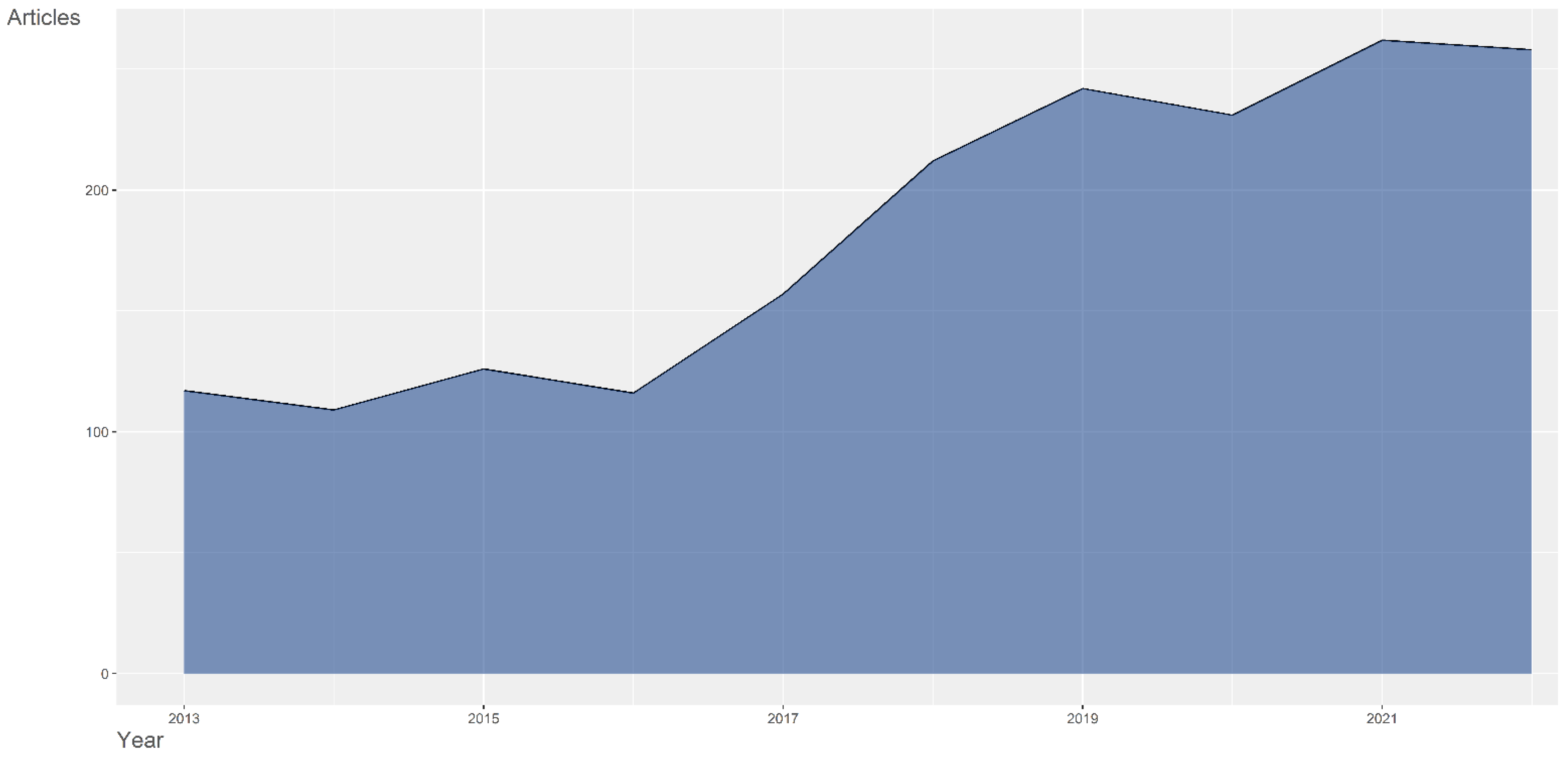
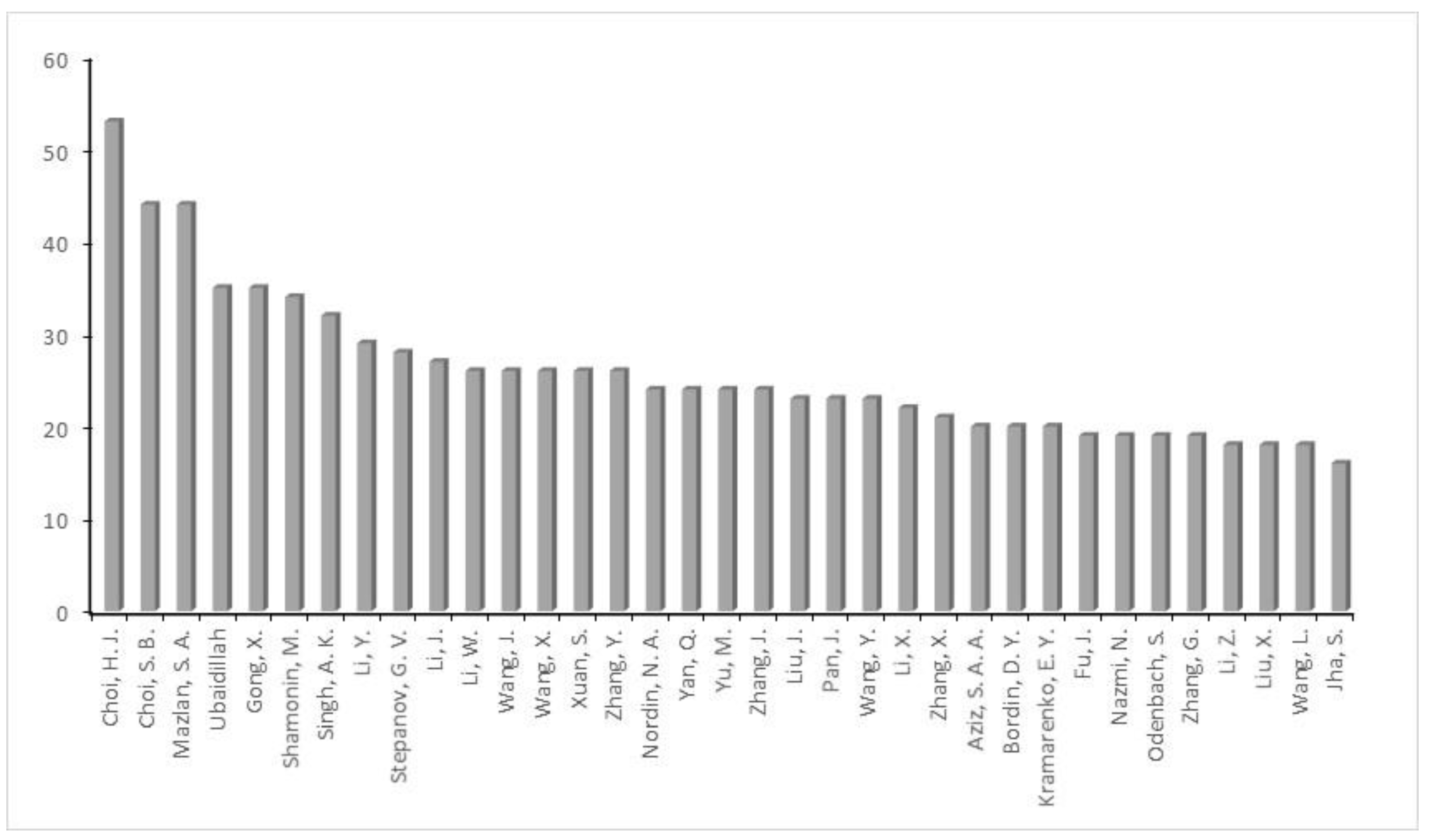


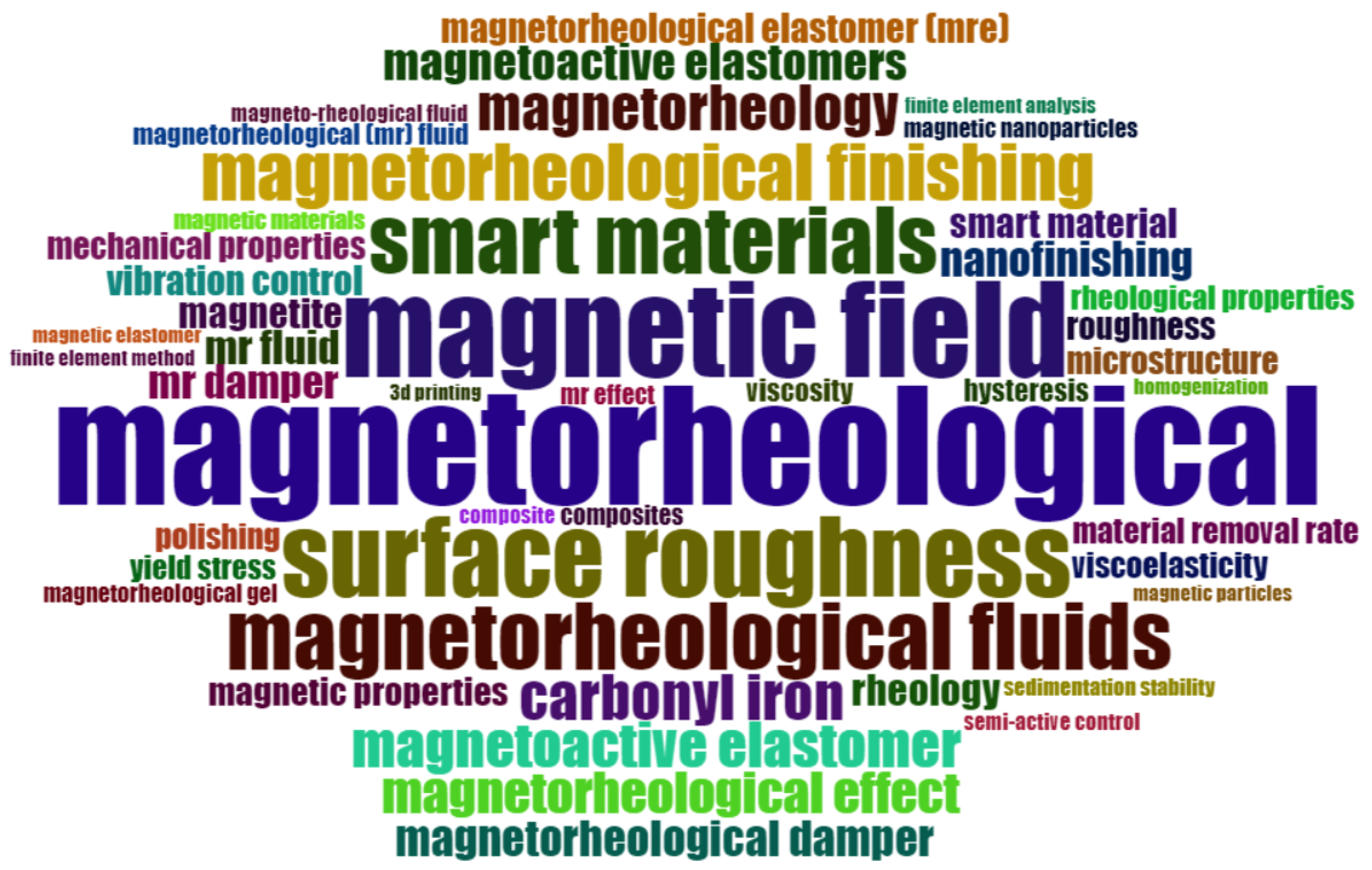

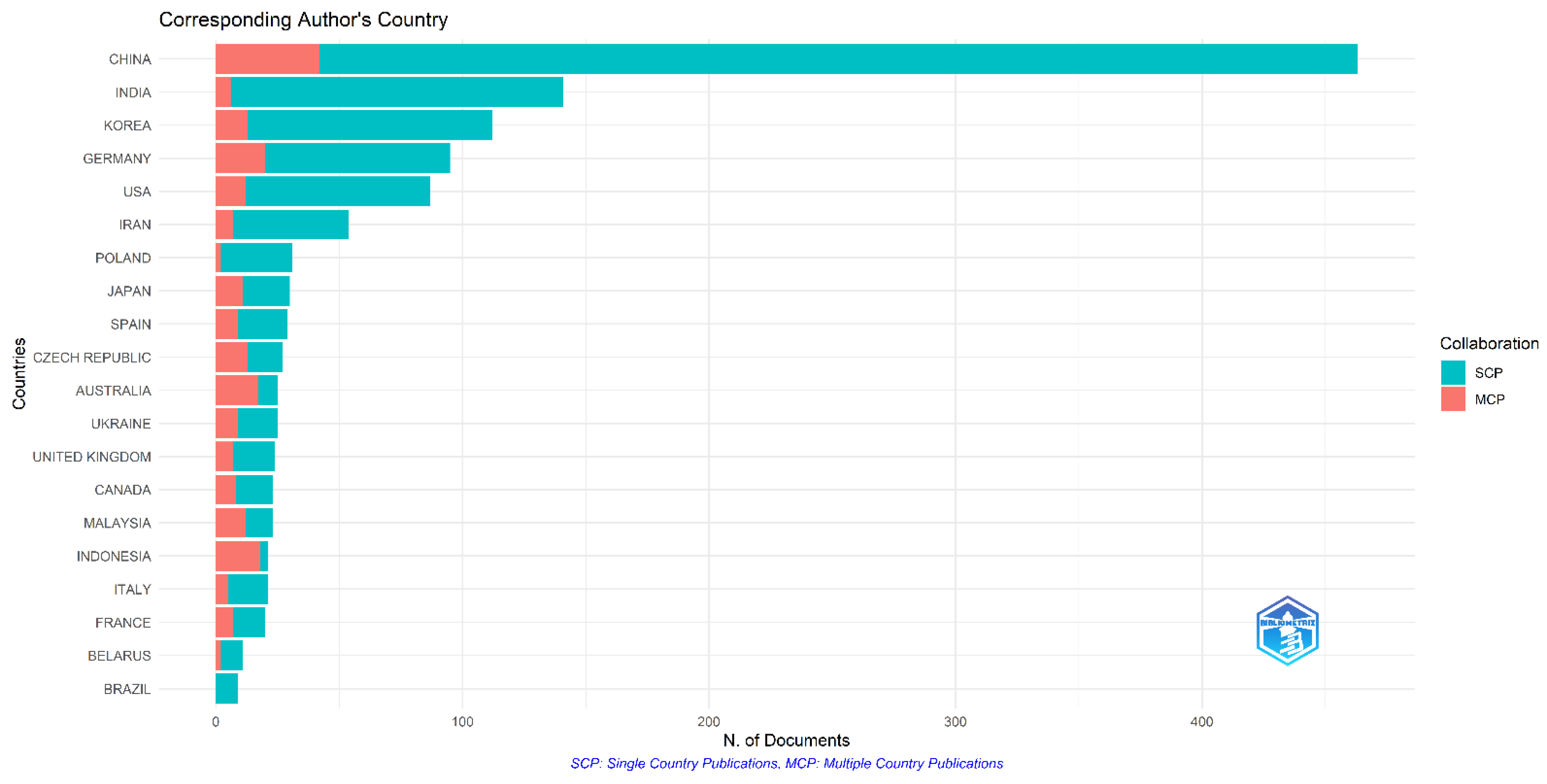
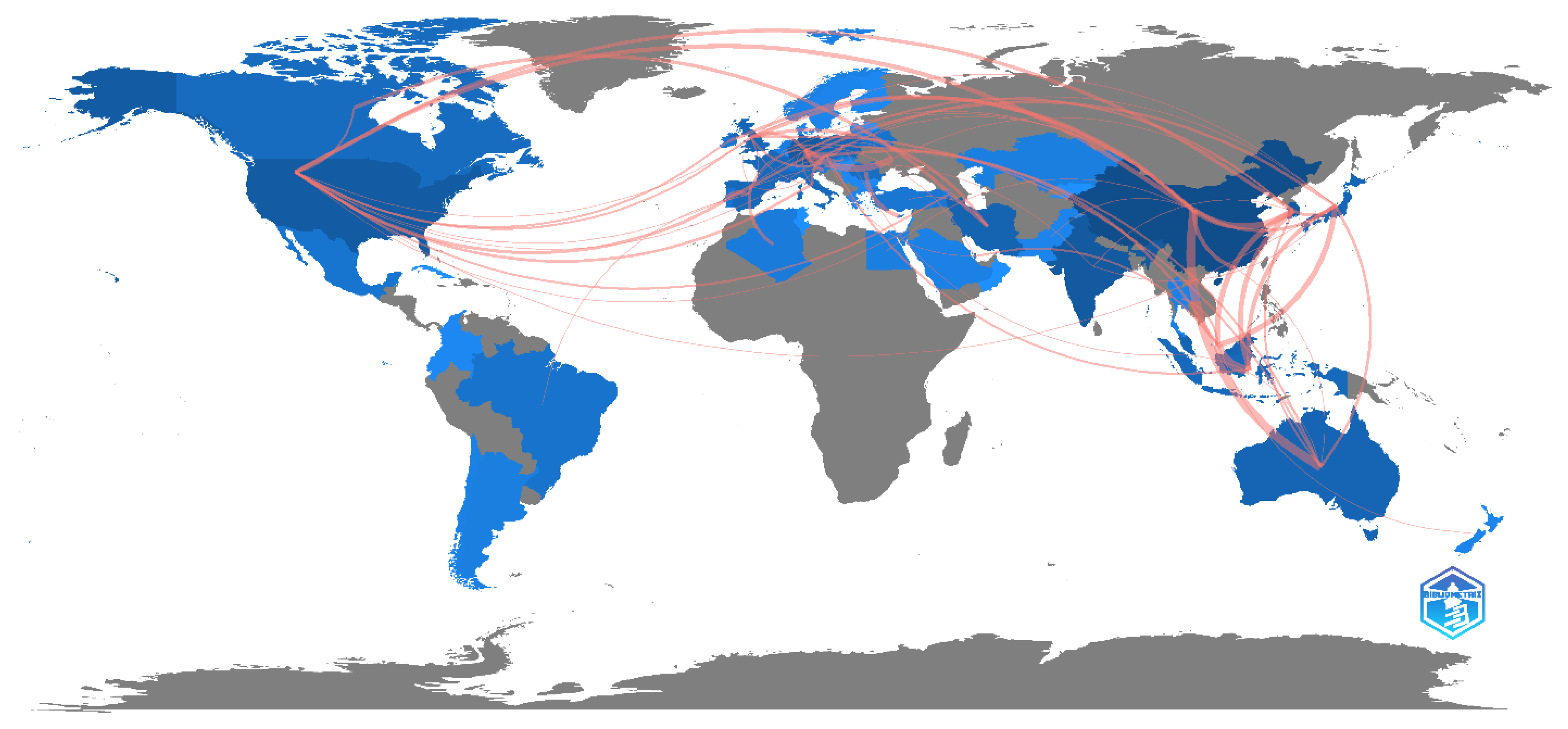

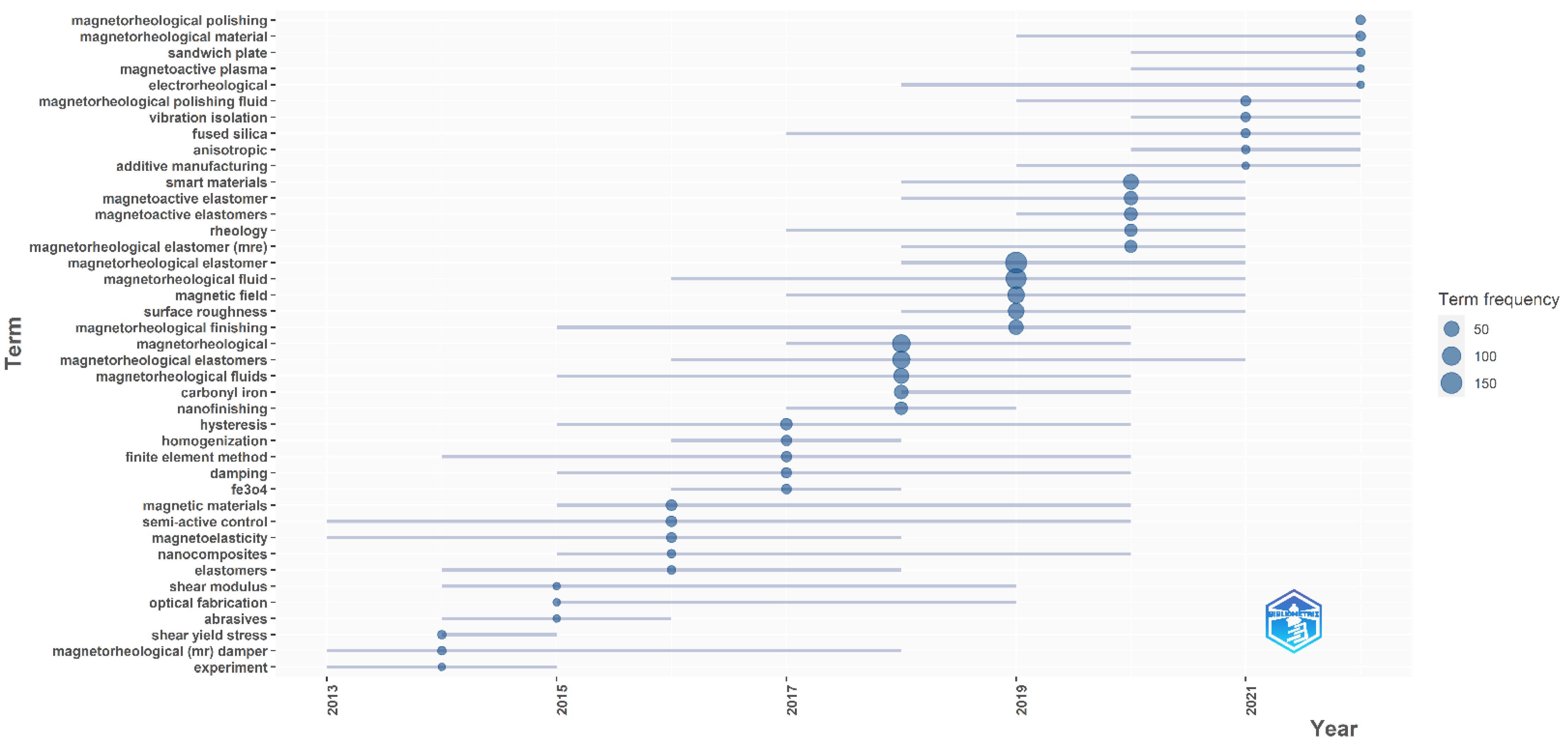
| Authors | Presented Study |
|---|---|
| Zhu, S et al. (2020) [38] | 15 Years of Small: Research Trends in Nanosafety |
| Merigo, J. M et al. (2018) [39] | Fifty years of Information Sciences: A bibliometric overview |
| Cheng, Y et al. (2020) [40] | A bibliometric analysis for the research on laser processing based on Web of Science |
| Zhu, S et al. (2021) [41] | A Bibliometric Analysis of Advanced Healthcare Materials: Research Trends of Biomaterials in Healthcare Application |
| Zhang, M et al. (2016) [42] | A bibliometric analysis of biodiesel research during 1991–2015 |
| Jiao, Y et al. (2021) [43] | A scientometric review of biochar preparation research from 2006 to 2019 |
| Davarazar, M et al. (2021) [44] | Engineered nanomaterials for (waste) water treatment—A scientometric assessment and sustainability aspects |
| Maier, A. and Manea, D. L. (2022) [45] | Perspective of Using Magnesium Oxychloride Cement (MOC) and Wood as a Composite Building Material: A Bibliometric Literature Review |
| Description | Results |
|---|---|
| Main information about data | |
| Timespan | 2013:2022 |
| Sources (journals, books, etc.) | 597 |
| Articles | 1830 |
| Average years from publication | 3.6 |
| Average citations per articles | 11.81 |
| Average citations per year per article | 2.391 |
| References | 56,706 |
| Article types | |
| Article | 1830 |
| Article contents | |
| Keywords plus (ID) | 9864 |
| Author’s keywords (DE) | 4316 |
| Authors | |
| Authors | 4016 |
| Author appearances | 7813 |
| Authors of single-authored articles | 45 |
| Authors of multi-authored articles | 3971 |
| Author collaborations | |
| Single-authored articles | 51 |
| Articles per author | 0.456 |
| Authors per article | 2.19 |
| Co-authors per article | 4.27 |
| Collaboration index | 2.23 |
| Position | Country | Articles | Intra-Country Collaboration | Inter-Country Collaboration | Total Citations | Average Article Citations |
|---|---|---|---|---|---|---|
| 1 | China | 463 | 421 | 42 | 4023 | 8.69 |
| 2 | India | 141 | 135 | 6 | 1673 | 17.61 |
| 3 | Korea | 112 | 99 | 13 | 1661 | 14.83 |
| 4 | Germany | 95 | 75 | 20 | 1588 | 11.26 |
| 5 | USA | 87 | 75 | 12 | 1553 | 17.85 |
| 6 | Iran | 54 | 47 | 7 | 784 | 31.36 |
| 7 | Poland | 31 | 29 | 2 | 685 | 12.69 |
| 8 | Japan | 30 | 19 | 11 | 489 | 18.11 |
| 9 | Spain | 29 | 20 | 9 | 409 | 20.45 |
| 10 | Czech Republic | 27 | 14 | 13 | 333 | 15.86 |
| 11 | Australia | 25 | 8 | 17 | 296 | 9.87 |
| 12 | Ukraine | 25 | 16 | 9 | 267 | 11.61 |
| 13 | United Kingdom | 24 | 17 | 7 | 236 | 8.14 |
| 14 | Canada | 23 | 15 | 8 | 227 | 9.87 |
| 15 | Malaysia | 23 | 11 | 12 | 217 | 9.04 |
| 16 | Indonesia | 21 | 3 | 18 | 195 | 6.29 |
| 17 | Italy | 21 | 16 | 5 | 183 | 26.14 |
| 18 | France | 20 | 13 | 7 | 158 | 17.56 |
| 19 | Belarus | 11 | 9 | 2 | 150 | 18.75 |
| 20 | Brazil | 9 | 9 | 0 | 118 | 14.75 |
| Position | Journal | H-Index | Total Citation | Number of Publications | Initial Publication Year |
|---|---|---|---|---|---|
| 1 | Smart Materials and Structures | 30 | 2956 | 153 | 2013 |
| 2 | Journal of Magnetism and Magnetic Materials | 16 | 606 | 42 | 2013 |
| 3 | Journal of Intelligent Material Systems and Structures | 15 | 647 | 54 | 2013 |
| 4 | Materials and Manufacturing Processes | 13 | 419 | 22 | 2013 |
| 5 | International Journal of Advanced Manufacturing Technology | 12 | 382 | 29 | 2013 |
| 6 | Composite Structures | 11 | 458 | 14 | 2014 |
| 7 | Soft Matter | 11 | 398 | 13 | 2013 |
| 8 | Composites Part B: Engineering | 9 | 326 | 9 | 2015 |
| 9 | Journal of Industrial and Engineering Chemistry | 9 | 202 | 10 | 2015 |
| 10 | Journal of the Mechanics and Physics of Solids | 9 | 510 | 9 | 2013 |
| 11 | Materials | 9 | 244 | 28 | 2015 |
| 12 | ACS Applied Materials and Interfaces | 8 | 277 | 14 | 2013 |
| 13 | Colloid and Polymer Science | 8 | 188 | 11 | 2013 |
| 14 | Colloids and Surfaces A: Physicochemical and Engineering Aspects | 8 | 195 | 15 | 2016 |
| 15 | Mechanical Systems and Signal Processing | 8 | 290 | 8 | 2018 |
| 16 | Polymers | 8 | 176 | 20 | 2017 |
| 17 | Advances in Materials Science and Engineering | 7 | 99 | 8 | 2013 |
| 18 | Applied Optics | 7 | 91 | 10 | 2014 |
| 19 | Frontiers in Materials | 7 | 113 | 16 | 2014 |
| 20 | IEEE Transactions on Magnetics | 7 | 160 | 25 | 2013 |
| Position | Title | Authors | Year | Total Citations | Citations per Year | Ref. |
|---|---|---|---|---|---|---|
| 1 | Development and characterization of a magnetorheological elastomer based adaptive seismic isolator | Li et al. | 2013 | 233 | 23.3 | [70] |
| 2 | Mechanics of hard-magnetic soft materials | Zhao et al. | 2019 | 172 | 43 | [71] |
| 3 | Experimental study and modeling of a novel magnetorheological elastomer isolator | Yang et al. | 2013 | 137 | 13.7 | [72] |
| 4 | Magnetic carbonyl iron/natural rubber composite elastomer and its magnetorheology | Jung et al. | 2016 | 124 | 17.714 | [73] |
| 5 | Experimental study of the magnetic field enhanced Payne effect in magnetorheological elastomers | Sorokin et al. | 2014 | 123 | 13.667 | [74] |
| 6 | Microstructure and rheology of magnetic hybrid materials | Odenbach | 2016 | 119 | 17 | [15] |
| 7 | Stretchable and magnetosensitive strain sensor based on silver nanowire-polyurethane sponge enhanced magnetorheological elastomer | Hu et al. | 2018 | 104 | 20.8 | [75] |
| 8 | Computational homogenization in magneto-mechanics | Javili et al. | 2013 | 103 | 10.3 | [76] |
| 9 | Magnetoactive Acoustic Metamaterials | Yu et al. | 2018 | 100 | 20 | [77] |
| 10 | Vibration analysis of sandwich rectangular plates with magnetorheological elastomer damping treatment | Jia-Yi Yeh | 2013 | 99 | 9.9 | [78] |
| 11 | Field responsive mechanical metamaterials | Jackson et al. | 2018 | 98 | 19.6 | [79] |
| 12 | Magnetic and viscoelastic response of elastomers with hard magnetic filler | Kramarenko et al. | 2015 | 95 | 11.875 | [80] |
| 13 | Hysteresis of the viscoelastic properties and the normal force in magnetically and mechanically soft magnetoactive elastomers: Effects of filler composition, strain amplitude and magnetic field | Sorokin et al. | 2015 | 94 | 11.75 | [81] |
| 14 | A finite-strain constitutive model for magnetorheological elastomers: Magnetic torques and fiber rotations | Galipeau | 2013 | 88 | 8.8 | [82] |
| 15 | Soft magnetorheological polymer gels with controllable rheological properties | Xu et al. | 2013 | 87 | 8.7 | [83] |
| 16 | A novel high-torque magnetorheological brake with a water cooling method for heat dissipation | Wang et al. | 2013 | 87 | 8.7 | [84] |
| 17 | On the properties of magnetorheological elastomers in shear mode: Design, fabrication and characterization | Dargahi et al. | 2019 | 85 | 21.25 | [85] |
| 18 | Synthesis of Silicone Elastomers Containing Silyl-Based Polymer-Grafted Carbonyl Iron Particles: An Efficient Way To Improve Magnetorheological, Damping, and Sensing Performances | Cvek et al. | 2017 | 85 | 14.167 | [86] |
| 19 | Stability of anisotropic magnetorheological elastomers in finite deformations: A micromechanical approach | Rudykh et al. | 2013 | 85 | 8.5 | [87] |
| 20 | Evaluation of highly compliant magneto-active elastomers with colossal magnetorheological response | Stoll et al. | 2013 | 81 | 9 | [88] |
| 21 | Modeling of particle interactions in magnetorheological elastomers | Biller et al. | 2014 | 79 | 8.778 | [89] |
| 22 | Multifunctional polymer composite with excellent shear stiffening performance and magnetorheological effect | Wang et al. | 2014 | 77 | 8.556 | [90] |
| 23 | Dynamic behavior analysis of a magnetorheological elastomer sandwich plate | Aguib et al. | 2014 | 75 | 8.333 | [91] |
| 24 | Seismic performance and probabilistic collapse resistance assessment of steel moment resisting frames with fluid viscous dampers | Seo et al. | 2014 | 74 | 8.222 | [92] |
| 25 | A new approach for modeling of magnetorheological elastomers | Norouzi et al. | 2016 | 74 | 10.571 | [93] |
| 26 | A novel hybrid magnetorheological elastomer developed by 3D printing | Bastola et al. | 2017 | 71 | 11.833 | [94] |
| 27 | Dynamic buckling of magnetorheological fluid integrated by visco-piezo-GPL reinforced plates | Fakhar et al. | 2018 | 70 | 14 | [95] |
| 27 | Magnetosensitive e-skins with directional perception for augmented reality | Bermudez et al. | 2018 | 70 | 14 | [96] |
| 28 | Enhancement of a magnetorheological PDMS elastomer with carbonyl iron particles | Perales-Martinez et al. | 2017 | 69 | 11.5 | [97] |
| 29 | Development of a multi-pole magnetorheological brake | Shiao et al. | 2013 | 67 | 6.7 | [98] |
| 30 | Magnetosensitive neurons mediate geomagnetic orientation in Caenorhabditis elegans | Vidal-Gadea et al. | 2015 | 65 | 8.125 | [99] |
| 31 | Design Considerations for Magnetorheological Brakes | Rossa et al. | 2013 | 65 | 7.222 | [100] |
| 32 | Resistor-capacitor (RC) operator-based hysteresis model for magnetorheological (MR) dampers | Bai et al. | 2019 | 64 | 16 | [101] |
| 33 | Effects of pressure and shear stress on material removal rate in ultra-fine polishing of optical glass with magnetic compound fluid slurry | Guo et al. | 2014 | 64 | 7.111 | [102] |
| 34 | Magnetically Addressable Shape-Memory and Stiffening in a Composite Elastomer | Testa et al. | 2019 | 63 | 15.75 | [103] |
| 35 | Shape Morphing of Hydrogels in Alternating Magnetic Field | Tang et al. | 2019 | 63 | 15.75 | [104] |
| 36 | A Liquid-Metal-Based Magnetoactive Slurry for Stimuli-Responsive Mechanically Adaptive Electrodes | Ren et al. | 2018 | 63 | 12.6 | [105] |
| 37 | Adaptive tuned vibration absorber based on magnetorheological elastomer-shape memory alloy composite | Kumbhar et al. | 2018 | 63 | 12.6 | [106] |
| 38 | Magnetic Actuation of Drops and Liquid Marbles Using a Deformable Paramagnetic Liquid Substrate | Vialetto et al. | 2017 | 63 | 10.5 | [107] |
| 39 | Magnetoreception—A sense without a receptor | Nordmann et al. | 2017 | 63 | 10.5 | [108] |
| 40 | Fabrication of polyaniline coated iron oxide hybrid particles and their dual stimuli-response under electric and magnetic fields | Sim et al. | 2015 | 63 | 7.875 | [109] |
Publisher’s Note: MDPI stays neutral with regard to jurisdictional claims in published maps and institutional affiliations. |
© 2022 by the authors. Licensee MDPI, Basel, Switzerland. This article is an open access article distributed under the terms and conditions of the Creative Commons Attribution (CC BY) license (https://creativecommons.org/licenses/by/4.0/).
Share and Cite
Ubaidillah, U.; Lenggana, B.W.; Choi, S.-B. Bibliometric Review of Magnetorheological Materials. Sustainability 2022, 14, 15816. https://doi.org/10.3390/su142315816
Ubaidillah U, Lenggana BW, Choi S-B. Bibliometric Review of Magnetorheological Materials. Sustainability. 2022; 14(23):15816. https://doi.org/10.3390/su142315816
Chicago/Turabian StyleUbaidillah, U, Bhre Wangsa Lenggana, and Seung-Bok Choi. 2022. "Bibliometric Review of Magnetorheological Materials" Sustainability 14, no. 23: 15816. https://doi.org/10.3390/su142315816





